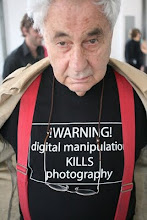Josef Koudelka sprang to fame - as Photographer X - for his images of the Russian invasion of his native Czechoslovakia in 1968. Before and since then, Koudelka has spent many years photographing gypsies; matching his lifestyle to theirs, travelling and living rough with them. From 1986 he also made very different images with a panoramic camera, depicting urban and rural landscapes devoid of people to reveal the impact of industrialisation. Other projects have included photographing the construction of the Channel Tunnel and the industrial pollution in Czechoslovakia.
Josef Koudelka’s latest book, "Lime" (Xavier Barral), follows up on the photographer’s work on Limestone (La Martinière, 2001). That work featuring 36 panoramic photographs was published in a limited edition of 500 copies and is today out-of-print.
In the 245-page "Lime", we find those same previously published photographs plus more recent ones on the same subject. In the text that accompanies the pictures, “Nature and Man: Josef Koudelka, The Freedom to Observe,” Jacqueline de Ponton d’Amécourt emphasizes the interest a number of painters since the 19th century have taken in rock quarries, from Gustave Courbet in 1850 and, later, Paul Cezanne at the Montagne Saint Victoire, to Pablo Picasso and the old quarries near the Chateau de Vauvenargues.
Like these great painters of the 19th century, Koudelka chose quarries as his subject. At the invitation of the largest global mining group, the photographer regularly visits quarries across the world. From 1999 to 2010, he visited 51 quarries in 11 countries, sometimes spending days on location. He brought back panoramic black-and-white photographs showing apocalyptic landscapes that show traces of mankind, even though the pictures lack human presence to provide a sense of scale.
It is for this reason that Koudelka does not consider this series as a commission, but rather a mission related to the “current concerns about man’s harmful effect on landscapes.” With this book, Koudelka touches on something timely and universal: human activity that permanently changes the landscape.
Others will see in this book an instance of Land Art.
Others will see in this book an instance of Land Art.
Bernard Perrine
Bernard.Perrine1@orange.fr
Bernard.Perrine1@orange.fr





























































